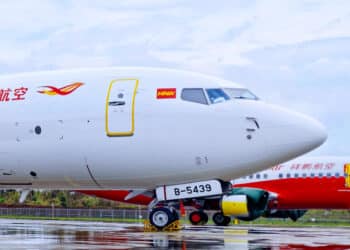Overheard at Cargo Facts Asia Part II: Carriers tell OEMs ‘Focus on Freighters’

SHANGHAI – Yesterday, we started our two-part coverage of our annual “Overheard at Cargo Facts Asia” review. You can revisit that story here. Today, in part II we shift away from the air cargo market for a look at developments related to freighter aircraft:
Carriers lobby OEMs to focus on freighters. The future supply of the 747F, the linchpin of the general air cargo market, is uncertain, and 747F operators on a trends panel during Cargo Facts Asia pressed Boeing and Airbus to develop alternatives. “When you think of the future supply of freighter aircraft, that is my most beloved question. Who is going to provide the next generation of freighters?” questioned Wolfgang Meier, president, SilkWay West Airlines. Meier suggested that within a couple of months, “We’re going to see what the fate of the -8F production will be.” Older 747-400BCFs have five to ten years left in service, added Meier. But what comes next?
Michael Steen, Executive Vice President and Chief Commercial Officer, Atlas Air Worldwide, encouraged both Boeing and Airbus to focus on freighters, cautioning that without competition, freighter supply could become too expensive, pushing modal shift. “The message to manufacturers is make sure that you work with us, too. Make the products more effective, more efficient and sustainable. That’s what we need to work together towards as an industry.” Meier concurred, “The answer is indeed a wider choice of acquirable, widebody aircraft. Bigger is better.”

MAX deliveries not yet minimizing NG pricing. At last year’s Cargo Facts Asia held in April 2017, speakers on a narrowbody panel were convinced that once deliveries of 737 MAX aircraft began, 737-800 feedstock prices would start to come down. The first 737 MAX was delivered shortly after the event in May 2017, and since then, 109 deliveries have been made, including at least twenty-eight to China-based airlines.
It appears, however, that it might be some time before feedstock prices come down enough to ramp-up conversion of 737 NGs. “When we talk about the -800s, feedstock prices are still on the high side, also, there are still a lot of -400s,” said Robert Convey, SVP Sales & Marketing, Aeronautical Engineers, Inc. But conversation rates of the NGs will eventually catch up, Convey assured the audience, adding, “My guess is that this will happen between 2023-2024 as suitable classic feedstock runs out.” Panelists agreed that price is everything when it comes to the success of a conversion program, and that each model has a trigger for conversions en-masse. With the 737-800s and A321s, panelists believe this trigger will be somewhere between $8-10 million for an airframe, which would give an on-ramp cost of around $15 million.
757 conversion programs are far from over, with some 223 passenger aircraft still available with around 28,000 cycles – what Brian McCarthy, VP, Sales, Precision Aircraft Solutions, refers to as “the sweet spot for 757 conversions.” Of those, 182 are 1998 vintage or younger. Recently, Precision has been completing about nineteen 757 conversions each year, and expects this rate to hold steady for another two to three years. McCarthy noted overwhelming demand has led to a “temporary period where engine support services are a bit difficult to find.” Regardless, McCarthy expects Precision will complete at least sixty more 757-200 conversions before the program ends, with at least twenty-five of those being re-delivered to China-based carriers.
To containerize or not to containerize (the lowerhold)? When it comes to the next generation of narrowbody freighters, one of the touted advantages of the A320/321 types has been the ability to use containers in the lower deck baggage compartments. Panelists argued, however, that with the Telair lowerhold sliding carpet, both models offer options to utilize the bellyhold. Whether or not a carrier chooses to install a cargo loading system or magic carpet, depends (like many things) on the type of cargo being carried, and the routes flown. Integrators with lower-density cargo are more likely to opt for lowerhold options as they look to maximize volume and reduce labor costs. For general cargo operators, the systems may be a tougher sell as payloads are often maximized using the maindeck alone, and the excess volume is unnecessary.
Drone technology is maturing, but safety concerns linger. On a panel discussing exciting technology developments expected to change the future of air freight, Leo Jeoh, program lead, Skyways, Airbus Helicopters, and Kourosh Hadi, director, airplane product development, Boeing Commercial Airplanes, agreed that technology for unmanned aerial vehicles (UAVs) is at least 90% in place already, with little engineering work remaining for the respective development teams. The logistics of actually putting UAVs into regular cargo service are another matter, and require addressing other issues, the most important and prominent of which is public safety and opinion. For the urban operations drone programs like Skyways are pursuing, even a very low failure rate stands to have an outsized impact on public opinion.
One approach to address safety concerns that is being pursued by Airbus and Boeing, among others, is to work alongside regulators during development, which allows developers and regulators the opportunity to address safety concerns before they arise during operations. Using technology like machine-learning to build in redundancies in case primary systems fail can also help reduce safety concerns. More systems also means higher costs, however, which may discourage potential applications for drone delivery and limit early drone shipments to high-value cargo. As Jeoh remarked, “nobody wants to pay $100 to post a letter.”




